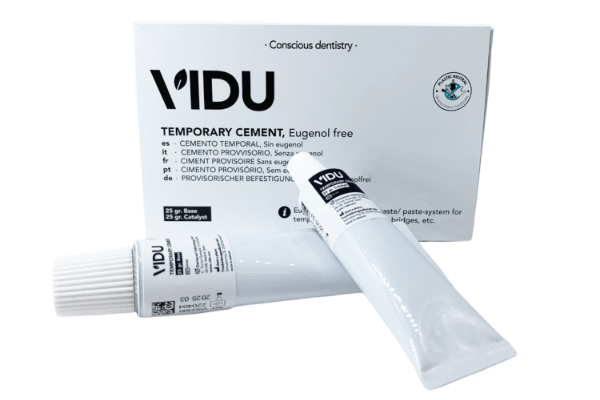Calcium hydroxide is one of the most widely used cements in dental clinics, both in restorative dentistry and endodontics. Furthermore, it is a very old and controversial dental cement, given that its ability to promote the formation of new dentin has been questioned since the beginning of the 20th century. In this article, we will tell you everything about calcium hydroxide cement, its properties, its uses in modern dentistry, and how to choose the most appropriate one for each clinical application. Are you ready?
It wasn't until the 19th or early 20th century that dentists began to consider conservative pulp and periodontal treatments more seriously; before then, extraction was simply the definitive and quick solution. In the 1930s, endodontics was recognized as a specialty within dentistry, and since then, research has focused on the new techniques, materials, and scientific principles of the time.
Uses of calcium hydroxide cement in dentistry
Calcium hydroxide has become an indispensable material in dental practice thanks to its antibacterial properties, biocompatibility, and ability to induce the formation of hard tissues. Its versatility allows it to be used in various procedures, both in restorative dentistry and endodontics, always with the aim of protecting the pulp and promoting the regeneration of dental tissues. Below, we review its main clinical applications.
Calcium hydroxide as a direct pulp capping
Dental pulp is a tissue with a capacity for repair that depends on the patient's age, periodontal condition, and stage of root formation. This capacity should be utilized!
Direct pulp capping is the procedure that attempts to preserve pulp vitality in cases where there is no history of persistent pain in response to external stimuli, when the pulp has been accidentally exposed.
Total removal of the coronal pulp, known as a pulpotomy, is currently the most widely accepted procedure for treating young primary and permanent teeth with pulp exposure due to caries or trauma. After removing the pulp from the crown of the tooth, the living tissue of the canals remains intact, and to protect it, calcium hydroxide cement is placed to promote healing and preservation. There is scientific evidence that calcium hydroxide cement yields good results in direct pulp capping, achieving the formation of reparative dentin and promoting pulp vitality, provided and only if the capping has been performed correctly and the pulp has not previously shown inflammation.

To evaluate the success of the treatment, a periapical radiograph should be taken to check for incipient lesions and to observe any changes in the size of the pulp chamber. Although the use of calcium hydroxide is still controversial, most authors favor its application, while those who oppose it argue that it is unpredictable due to its poor sealing capacity.
Calcium hydroxide as an indirect pulp capping material
Indirect pulp capping consists of preserving a quantity of carious dentine at the bottom of the cavity preparation in order to avoid exposing the pulp. Afterwards, calcium hydroxide cement is applied to stimulate and promote pulp recovery.

In this procedure, calcium hydroxide not only stimulates dentin formation, but also induces remineralisation of softened dentin and protects it from germs. According to numerous studies, this treatment has been shown to be over 90% successful and, although it does not have a sedative effect, it does have excellent antibacterial and anti-inflammatory properties, which means it can be used under any restorative material. Researchers Gani and Crosa affirm that the formation of sclerotic dentine due to the effect of calcium hydroxide is indisputable and that since Hermann introduced calcium hydroxide into dentistry, no other medication has been able to replace it as a pulp protector.
Calcium hydroxide in endodontics
Calcium hydroxide has been and continues to be widely used in endodontics for pulp protection treatments, partial biopulpectomies, repair of periodontal perforations, cemento-dentin resorption, desensitisation and even in irrigating solutions and intra-canal medication between sessions. In addition to being used, of course, in calcium hydroxide-based endodontic sealing cements, such as Septodont's Bioroot RCS.
Despite being a valuable cement for endodontics and having been used for over a century, its mechanism of action remains poorly understood and is not well supported.
How does calcium hydroxide act on tissues?
The action of calcium hydroxide on tissues is related to its ionic dissociation, which generates hydroxyl ions (OH-). Hydroxide ions are monovalent reducing radicals that can only lose one electron to the surrounding medium, meaning they can be oxidized. This ionic dissociation of calcium hydroxide produces resulting products that are responsible for the biological effect on vital tissues and microorganisms, such as the formation of hard tissues and antibacterial properties, respectively.
Calcium hydroxide causes superficial necrosis on the body's cells and also induces calcification of the pulp tissue. Therefore, some authors describe its effect as antagonistic and paradoxical. Damage to vital tissues is influenced by pH, but also by the solubility of the caustic, its dehydrating effect, its reaction with cellular components, and the degree of tissue penetration. An alkaline pH produces coagulative necrosis, hydrolytic cleavage of lipids into organic acids and alcohols, protein denaturation, capillary thrombosis, and finally, tissue healing.
Regarding its antibacterial action, calcium hydroxide has a bactericidal effect when it comes into direct contact with bacteria and also acts indirectly by obliterating the spaces of the dentinal tubules, reducing the utilization of nutrients by the microorganisms present in the dentin, and absorbing the carbon dioxide essential for their survival.
Calcium hydroxide cement formulations for different uses in dentistry
Depending on the intended use of calcium hydroxide cement, there are various product formulations available on the market. Below, we will tell you about some of them.
Calcimol LC by Voco: indirect pulp capping
Voco's Calcimol LC cement is a light-curing, radiopaque calcium hydroxide ideal for indirect pulp capping or for use as a base under any restorative material. This cement is perfect for this use and promotes the formation of tertiary dentine.

Dentsply Dycal: direct and indirect pulp capping and lining
Dentsply Dycal calcium hydroxide cement is self-curing and comes in two pastes: base and catalyst. It is indicated for both direct and indirect pulp capping and also as a protective liner prior to the application of adhesive, varnish, cement or any other restorative material. Its composition does not interfere with the polymerisation of other materials.

UltraCal XS by Ultradent: temporary intra-canal medication
Ultradent's UltraCal XS calcium hydroxide cement has an antibacterial effect on microorganisms inside the canals despite not coming into direct contact with them. This occurs due to the creation of a high pH environment and the absorption of CO2, which bacteria need for growth.

See Ultradent UltraCal XS cement
Vidu eugenol-free temporary cement: temporary fixation of crowns and bridges
Vidu eugenol-free temporary cement contains calcium hydroxide and hydroxyapatite. It takes advantage of the antibacterial and dentine-forming properties of calcium hydroxide to protect preparations between sessions. It comes in two pastes: base and catalyst, and its use does not affect the polymerisation of other materials, as a cement containing eugenol would. And if that weren't enough, like all Vidu products, it has a zero plastic footprint.

See Vidu temporary cement without eugenol
Take a look at the best-selling calcium hydroxide cements:
View all calcium hydroxide cements
In conclusion, we could say that the discrepancies regarding calcium hydroxide have not disappeared over time. however, today we know much more than we did a century ago and we can understand its biological effect at the molecular level, its action on vital tissues, the most appropriate pH for its use, how new dentine is formed and how its indisputable antibacterial action occurs.
Calcium hydroxide is an important alternative in modern dentistry. Nevertheless, as always, the decision to use it must be based on excellent clinical judgement and sound reasoning in order to avoid errors that may arise due to the unpredictability of the results.
We hope we have told you something new about this important cement that is widely used in dentistry. If you liked our article, don't forget to follow us on social media to stay up to date with the latest advances in the dental sector that make your day-to-day life easier. If you have any questions, please do not hesitate to contact us, we will be happy to help you. See you soon!


